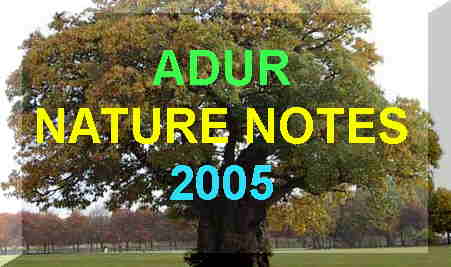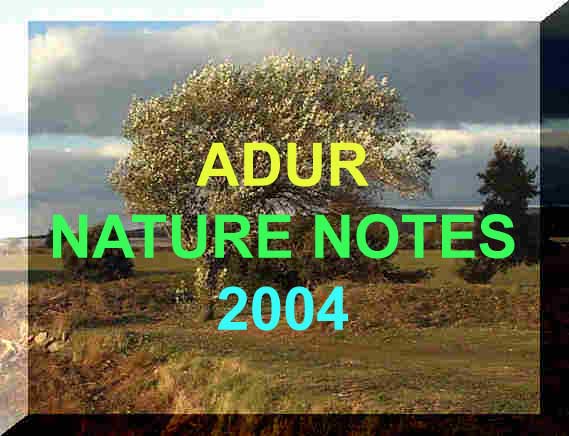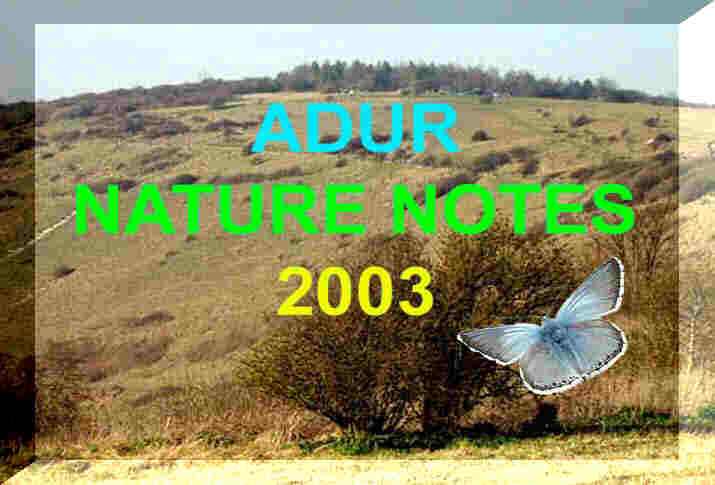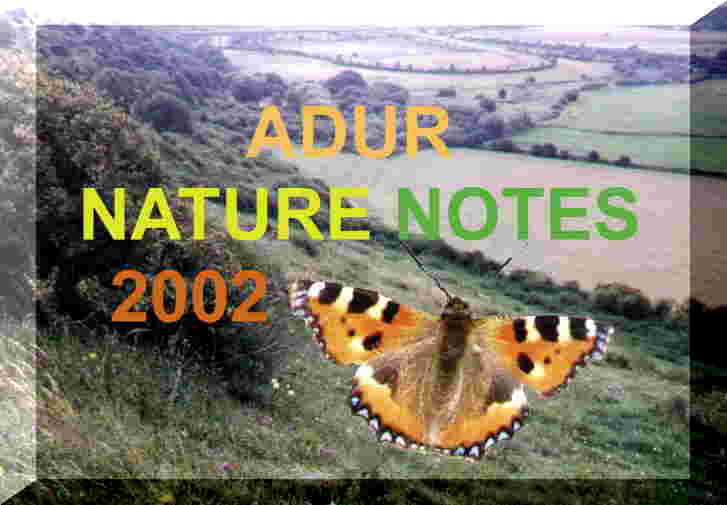16 December 2005
| 8
July 2005
Hoverfly on Ragwort This
is a mimic of a bumblebee because of the short antennae and hoverfly
face.
Slonk Hill Cutting, south bank
|
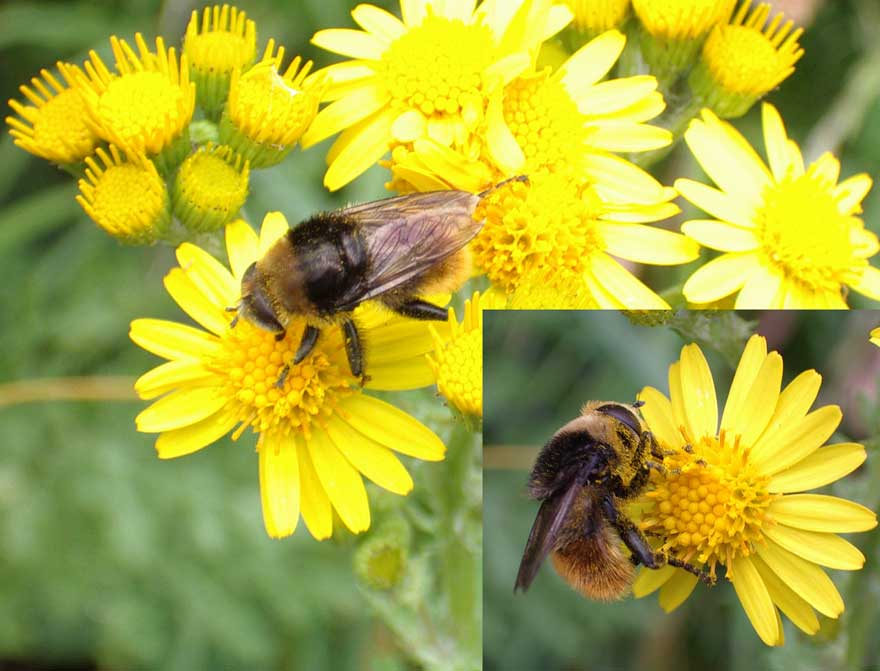 |
 |
7
July 2005
Common Carder Bee Bombus pascuorum, favouring Restharrow on the Slonk Hill Cutting (south). |
| 16
May 2005
The black colour of some bumblebees makes them difficult to photograph. The images on the right of the Red-tailed Bumblebee, Bombus lapidarius, was taken in the linear spinney of the south side of the Slonk Hill Cutting. A small orange mite was seen on this bee. |
 |
 |
21
April 2005
 A
handful of Red-tailed
Bumblebees, Common Carder Bees
Bombus
pascuorum, favouring White Dead Nettle,
and at least one Buff-tailed Bumblebee
from
the wooded path (linear spinney) by Slonk Hill
South were observed in passing.
A
handful of Red-tailed
Bumblebees, Common Carder Bees
Bombus
pascuorum, favouring White Dead Nettle,
and at least one Buff-tailed Bumblebee
from
the wooded path (linear spinney) by Slonk Hill
South were observed in passing.
19
April 2005
A
Red-tailed
Bumblebee,
Bombus
lapidarius, nectared on Dog Violet
on
the lower slopes of Mill
Hill.
17
April 2005
The
Red-tailed
Bumblebee,Bombus
lapidarius, was definitely confirmed from the wooded path by Slonk
Hill South and the Common Carder Bee,
Bombus
pascuorum, from Shoreham gardens
and wasteland.
15
April 2005
There
were scores of bumblebees in gardens and on wasteland on the edge of town.
Buff-tailed
Bumblebees were identified, but there
were other species as well, almost certainly the
White-tailed
Bumblebee, Bombus lucorum; but
I am not sure about the Red-tailed
Bumblebee,
Bombus
lapidarius, as I was unable to confirm this one.
 |
I have identified this as
the
White-tailed
Bumblebee, Bombus lucorum. This
may be wrong mad could very well be a Buff-tailed
Bumblebee.
It was one of several seen during the day, this one from the Dovecote Bank. |
 |
15
April 2005
This
bee in the photograph on the left is very likely a queen
Bombus
pascuorum. Not the male of Anthophora
plumipes which has the integument of the
labrum, clypeus and lower paraocular areas (collectively the lower face)
bright yellow; in addition the base of the mandible and the ventral surface
of the antennal scape are all bright yellow. All these structures in your
portrait are black.
ID
by George Else on the on the
Bees,
Wasps and Ants Recording Society Yahoo Group
|
3 April
2005
There
were scores of Buff-tailed Bumblebees
in gardens and the downs (Mill Hill) including,
or perhaps mostly, queens.
There was at least one Mining Bee as
well in the back garden of 40 The Drive (near
Buckingham Park), (TQ 219 063)
Adur
Mining Bees
7 March
2005
At
least two queen
Buff-tailed Bumblebees
flew
around, crashing at least three times at full speed into the glass pane
of the French windows at 40 The Drive (near
Buckingham Park), (TQ 219 063).
2 February
2005
Just
after midday, the first burst of sunshine of the year felt warm in a shade
temperature of 9.7 ºC.
This
attracted 25+ dark Honey Bees
to a Hebe shrub
in The Drive (near Buckingham Park), Shoreham, plus a queen
Buff-tailed
Bumblebee.
2 January
2005
A
bumblebee
flew rapidly over the back garden of 40 The Drive (near Buckingham Park),
(TQ 219 063).
25
October 2004
Nothing
of special note apart from the small bee
(photographed below on the right) on the Devil's
Bit Scabious. It was much slenderer and smaller
than the Carder Bee.
Its abdomen was also more distinctly "zebra"
striped in black and white and not furry like the usual Carders. The legs
are partly white in this specimen when bumblebee
legs are usually black. The nearest match from the Collins Guide by Michael
Chinery (p. 244) is Halictus scabiosa.
PS:
The Old Collins Guide shows a better match for Lasioglossum
malachurus, but this species has yellow
legs. Neither of the illustrations are detailed enough to be sure as it
could also be a species of Colletes.
Colletes
hedera is a feeder on Ivy late in the
year. This last one seems most likely, but it is still not quite right.
The
consensus on the British
Insects (Yahoo Group) is that this small bee is a species of Lasioglossum,
but
the species is unlikely to be identified by a photograph (I did not think
it was anything special when I photographed it).
The solitary bee is Lasioglossum xanthopum - the largest British species of the genus, with males that peak much later than any other species (typically late September/early October - we are still trying to work out how it mates as you rarely see females at this time of year). It is a rather calcicolous species and frequent on the Sussex downs, though I have never surveyed these late enough to see males. It is graded Nationally Scarce at the moment. It can be confused for the similiar Halictus rubicundus (slightly smaller with abdominal dust spots at the apices of the tergites as opposed to the bases like your photo).
Bramble Bees and Others (by J. Henri Fabre)
Solitary Bees Page
20
October 2004
Approaching
dusk, it was nearly dark when I squelched the muddy trail of the lower
slopes of Mill Hill.
 |
A Carder Bee (bumblebee) was asleep on the underside of a Devils's Bit Scabious flower.
24
September 2004
This
is the Common Carder Bee, Bombus
pascuorum photographed below. They were frequent on the lower
slopes of Mill Hill.
27
September 2004.
 |
 |
18
August 2004
The
following photographs were taken in the Butterfly
Copse (TQ 209 063)
by the Waterworks Road.
This one is the Common Carder Bee, Bombus pascuorum. Its legs are all black.
1
July 2004
 |
 |











